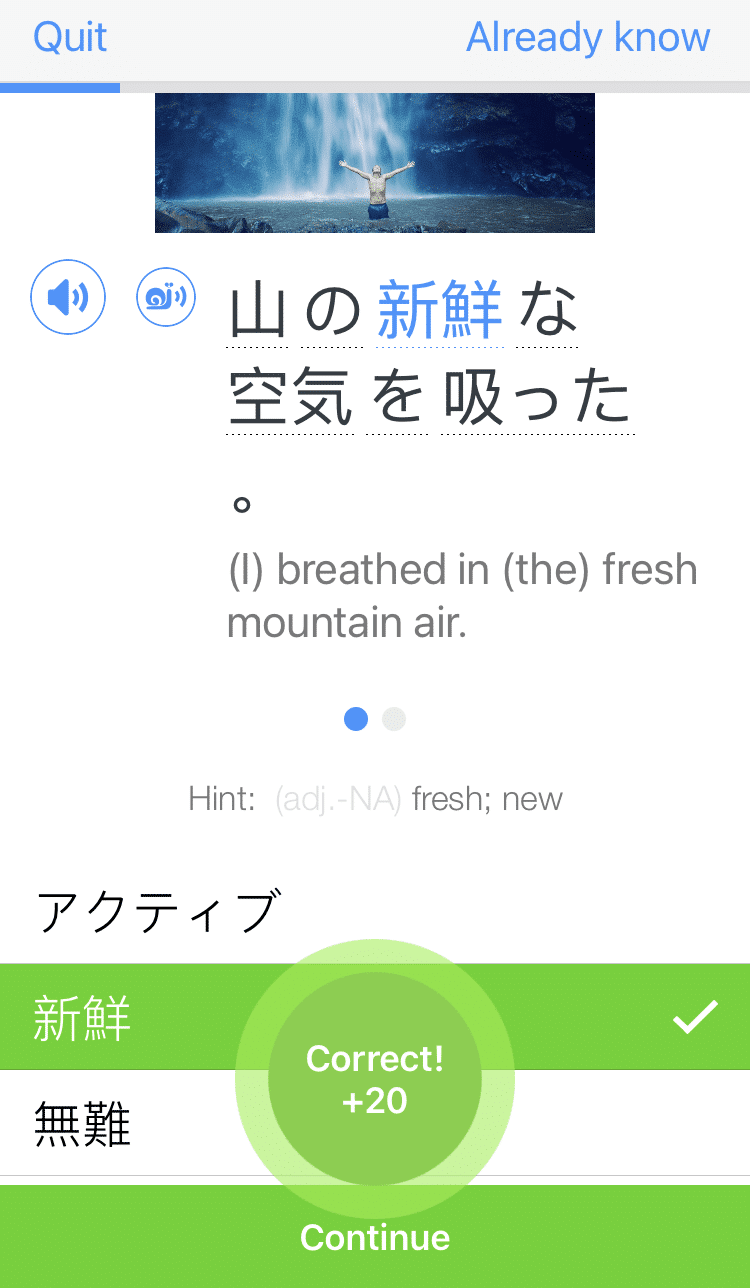Contents
150+ Japanese Adjectives to Describe People, Places and Things

Can you describe your world in full color?
Or are you stuck in black-and-white?
In this post, we’ll give you more than 150 essential adjectives for adding some color to your own Japanese speech.
You’ll also learn how to use Japanese -い and -な adjectives in a sentence, since Japanese adjectives are a bit trickier to use than their English counterparts.
Let’s learn some Japanese adjectives!
Download: This blog post is available as a convenient and portable PDF that you can take anywhere. Click here to get a copy. (Download)
How い-adjectives Work
These are adjectives that, as the name implies, typically end in the letter い, such as:
- 寒い, samui (cold)
- 高い, takai (expensive/tall)
- 忙しい, isogashii (busy)
These words can simply be dropped in front of the noun you want to modify.
Alternatively, they can be conjugated at the end of a sentence. Here’s the word for “cold” in its various conjugations:
| Casual (romaji) | Casual (Japanese) | Formal (Japanese) | Formal (romaji) | |
|---|---|---|---|---|
| Present | 寒い | samui | 寒いです | samui desu |
| Past | 寒かった | samukatta | 寒かったです | samukatta desu |
| Negative | 寒くない | samukunai | 寒くありません | samuku arimasen |
| Past negative | 寒くなかった | samukunakatta | 寒くありませんでした | samuku arimasen deshita |
And here they are in full sentences:
| English | Casual (Japanese) | Casual (romaji) | Formal (Japanese) | Formal (romaji) |
|---|---|---|---|---|
| It's cold today. | 今日は寒い。 | Kyou wa samui. | 今日は寒いです。 | Kyou wa samui desu. |
| Yesterday was cold. | 昨日は寒かった。 | Kinou wa samukatta. | 昨日は寒かったです。 | Kinou wa samukatta desu. |
| It's not cold today. | 今日は寒くない。 | Kyou wa samukunai. | 今日は寒くありません。 | Kyou wa samuku arimasen. |
| It wasn't cold yesterday. | 昨日は寒くなかった。 | Kinou wa samukunakatta. | 昨日は寒くありませんでした。 | Kyou wa samuku arimasen deshita. |
If you want to link the adjective more intimately to its noun by placing them together, here’s how you would do it.
寒い日です。 Samui he desu. (It’s a cold day. [Formal])
明日は寒い日です。 Ashita wa samui he desu. (Tomorrow will be a cold day. [Formal])
寒い日でした。 Samui deshita. (It was a cold day. [Formal]).
昨日は寒い日じゃなかった。 Kinou wa samui he ja nakatta. (Yesterday wasn’t a cold day. [Casual]).
Note that in the casual negative and casual past negative conjugations じゃ (ja) is used, whereas in the formal versions it’s では (dewa) instead.
じゃ is simply a contraction of では. You can use じゃ when speaking the majority of the time, except for highly formal occasions (graduation commencement speeches, funerals, etc.).
However, it’s the opposite in writing. Typically, it’ll be written as では unless it’s decidedly informal (quoting casual speech, manga, etc.).
How な-adjectives Work
Japanese -な adjectives place a な between the adjective and noun it’s modifying. When one of these adjectives isn’t directly proceeding a noun, it can drop the -な.
These adjectives need to be conjugated with です, since な-adjectives themselves aren’t the target of conjugation. As such, they’ll follow the same pattern as conjugating です.
As an example, let’s look at how to say whether someone is “serious”:
| Casual (Japanese) | Casual (romaji) | Formal (Japanese) | Formal (romaji) | |
|---|---|---|---|---|
| Present | 真面目だ | majimeda | 真面目です | majime desu |
| Past | 真面目だった | majime datta | 真面目でした | majime deshita |
| Negative | 真面目じゃない | majime ja nai | 真面目ではありません | majime de wa arimasen |
| Past negative | 真面目じゃなかった | majime ja nakatta | 真面目ではありませんでした | majime de wa arimasen deshita |
And here they are in use:
| English | Casual (Japanese) | Casual (romaji) | Formal (Japanese) | Formal (romaji) |
|---|---|---|---|---|
| The teacher is serious. | 先生は真面目だ。 | Sensei wa majimeda. | 先生は真面目です。 | Sensei wa majime desu. |
| The teacher was serious. | 先生は真面目だった。 | Sensei wa majime datta. | 先生は真面目でした。 | Sensei wa majime deshita. |
| The teacher isn't serious. | 先生は真面目じゃない。 | Sensei wa majime ja nai. | 先生は真面目ではありません。 | Sensei wa majime de wa arimasen. |
| The teacher wasn't serious. | 先生は真面目じゃなかった。 | Sensei wa majime ja nakatta. | 先生は真面目ではありませんでした。 | Sensei wa majime de wa arimasen deshita. |
Besides the use of な between adjective and noun, the adjective itself doesn’t change regardless of the tense of nature of the sentence:
彼女は真面目な先生だ。 Kanojo wa majimena sensei da. (She’s a serious teacher. [Casual])
彼女は真面目な先生でした。 Kanojo wa majimena sensei deshita. (She was a serious teacher. [Formal])
彼女は真面目な先生じゃなかった。 Kanojo wa majimena sensei ja nakatta. (She wasn’t a serious teacher. [Casual])
By now it should be pretty clear that Japanese adjectives don’t work exactly the same as English ones. Paying attention to how these words work as you learn them will make these words easier to remember and incorporate into your everyday Japanese.
Look for examples of their use in Japanese media. The FluentU program can help you with this.
FluentU takes authentic videos—like music videos, movie trailers, news and inspiring talks—and turns them into personalized language learning lessons.
You can try FluentU for free for 2 weeks. Check out the website or download the iOS app or Android app.
P.S. Click here to take advantage of our current sale! (Expires at the end of this month.)

Descriptive Adjectives
These are the types of words you think of when you think “adjectives,” those that describe and modify nouns. Here you’ll find the most common adjectives, those describing color, shape, size, etc.
Size and shape adjectives
大きい , ooki (Big)
小さい , chiisai (Small)
重い , omoi (Heavy)
軽い , karui (Light)
丸い , marui (Round)
四角い , shikakui (Square)
角ばった , kaku batta (Angular)
直線的な , chokusenteki na (Straight)
曲線的な , kyokusenteki na (Curved)
鋭い , surudoi (Sharp)
長い , nagai (Long)
短い , mijikai (Short)
広い , hiroi (Wide/Spacious)
狭い , semai (Narrow/Cramped)
細い , hosoi (Thin)
太い , futoi (Thick/Fat)
浅い , asai (Shallow)
深い , fukai (Deep)
高い , takai (Tall/High)
低い , hikui (Short/Low)
不規則な , fukisoku na (Irregular)
Color adjectives
明るい , akarui (Bright)
暗い , kurai (Dark)
赤い , akai (Red)
青い , aoi (Blue)
黄色い , kiiroi (Yellow)
緑の , midori no (Green)
オレンジ色の , orenji iro no (Orange)
紫の , murasaki no (Purple)
橙色の , daidai iro no (Orange)
黒い , kuroi (Black)
白い , shiroi (White)
灰色の , haiiro no (Gray)
茶色の , chairo no (Brown)
金色の , kin iro no (Gold)
銀色の , gin iro no (Silver)
ピンク色の , pinku iro no (Pink)
青緑色の , aomidori iro no (Turquoise)
濃い青色の , koi aoiro no (Navy blue)
ベージュ色の , beiju iro no (Beige)
肌色の , hada iro no (Skin color)
Personality adjectives
優しい , yasashii (Kind)
真面目な , majime na (Serious)
活発な , kappatsu na (Active)
真っ直ぐな , massugu na (Honest/Straightforward)
頑固な , ganko na (Stubborn)
冷静な , reisei na (Calm)
礼儀正しい , reigi tadashii (Polite)
熱心な , nesshin na (Enthusiastic)
意地悪な , ijiwaru na (Mean)
大胆な , daitan na (Bold)
臆病な , okubyou na (Timid)
穏やかな , odayaka na (Gentle)
陽気な , youki na (Cheerful)
意外な , igai na (Surprising/Unpredictable)
楽観的な , rakkanteki na (Optimistic)
悲観的な , hikanteki na (Pessimistic)
無口な , mukuchi na (Reserved/Quiet)
社交的な , shakou teki na (Sociable)
元気な , genkina (Energetic)
面倒くさい , mendoukusai (Bothersome)
人懐っこい , hitonatsukkoi (Friendly/Approachable)
おおらかな , ooraka na (Easygoing)
気が強い , kiga tsuyoi (Strong-willed)
気まぐれな , kimagure na (Capricious)
勤勉な , kinben na (Diligent/Hardworking)
臆病な , okubyou na (Cowardly/Timid)
極端な , kyokutan na (Extreme)
Common descriptive adjectives
良い , yoi (Good)
悪い , warui (Bad)
速い , hayai (Fast)
遅い , osoi (Slow)
高い , takai (Expensive/High)
安い , yasui (Inexpensive/Cheap)
新しい , atarashii (New)
古い , furui (Old)
美しい , utsukushii (Beautiful)
汚い , kitanai (Dirty)
暑い , atsui (Hot)
寒い , samui (Cold)
忙しい , isogashii (Busy)
静かな , shizuka na (Quiet)
賑やかな , nigiyaka na (Lively)
かわいい , kawaii (Cute)
おいしい , oishii (Delicious)
まずい , mazui (Bad-tasting)
つまらない , tsumaranai (Boring)
たのしい , tanoshii (Fun/Enjoyable)
かっこいい , kakkoii (Cool/Good-looking)
Comparative and Superlative Adjectives
Comparative
As you might imagine, these ones are for comparing things. But comparisons don’t work in Japanese the same way they do in English. There are no words for “better,” “worse” or “faster.” Instead, you can use words like もっと, which means “more,” to indicate that what you’re talking about is to a higher degree than normal.
速い , hayai (Fast) → もっと速い , motto hayai (More fast/faster)
You can also use の方が (no hou da) as a way of saying something is “more than.” It’s not necessary to have something specific to compare to when using this construction.
それの方が美味しいです。 Sore no hou da oishii desu. (That one is more delicious.)
For comparison between multiple things, you can use より (yori). You might also see or hear よりも (yori mo), but there’s no difference between it and より.
明日は、今日より暑い。 Ashita wa, kyou yori atsui. (Tomorrow will be hotter than today.)
Here are a few more:
一層…な , issou …na (Even more…)
一層…い , issou …i (Even more…)
比較的…な , hikakuteki …na (Comparatively…)
比較的…い , hikakuteki …i (Comparatively…)
以上に…な , ijou ni …na (More than…)
以上に…い , ijou ni …i (More than…)
These comparative adjectives are used to compare two or more things, indicating that one thing is more or less of a certain quality than another thing. For example:
比較的高い。 Hikakuteki takai. (Relatively expensive/high.)
Superlative
Just as there are no direct corresponding words for “better” or “worse,” there’s similarly no exact vocabulary for “best” or “worst.” Rather, there are a few words that can be attached to others to indicate that they’re to the utmost degree.
一番 , ichiban (Number one, best)
最も , motto mo (Most)
The latter is typically a bit more formal, but you’ll hear the former relatively frequently in casual conversation.
寿司は私の一番好きな食べ物です。 Sushi wa watashi no ichiban sukina tabemono desu. (Sushi is my favorite food.)
Note: In Japanese, 好き (suki — like) is an adjective, not a verb as it is in English. Alternatively, think of it as meaning “desirable.” And not only is it an adjective, it’s a な-adjective, thus the -な between 好き and 食べ物.
Here are some more superlative adjectives in Japanese:
最高の , saikou no (The best)
最低の , saitei no (The worst)
最大の , saidai no (The biggest)
最小の , saishou no (The smallest)
最上の , saijou no (The finest)
最悪の , saiaku no (The worst)
Quantitative Adjectives
Describing amounts of things. This can include numbers, words referring to amounts and some counters.
Here are some adjectives for amounts:
半分 , hanbun (Half)
Note: ハーフ (haafu) can also mean “half,” but it carries other connotations that you probably don’t intend. So even though 半分 (hanban) may technically refer to “half a minute,” it’ll be understood as “half” in most contexts.
全部 , zenbu (Whole)
沢山 , takusan (A lot/many)
少し , sukoshi (A little)
多い , ooi (Many/Numerous)
幾つかの , ikutsuka no (Some/Several)
大量の , tairyou no (Large quantity/Great amount)
少量の , shouryou no (Small quantity/Small amount)
多数の , tasuu no (a large number of/Many)
少数の , shousuu no (a small number of/Few)
And as you may know, Japanese has many different counters for many different types of things. A rundown of some of the more common and important ones can be found here.
Demonstrative Adjectives
These adjectives are for determining which noun or pronoun you’re referring to.
この , kono (this)
その , sono (that)
あの , ano (that over there)
これらの , korera no (these)
Possessive Adjectives
Japanese doesn’t have particular words for relationships of ownership. Instead, they use the particle の to indicate possession.
私の , watashi no (Mine)
彼女の , kanojo no (Hers)
彼の , kare no (His)
私達の , watashitachi no (Ours)
あなたの , anata no (Yours)
Interrogative Adjectives
These are question words that modify nouns.
どの , dono (Which)
どちら , dochira (Which [of two options], where, which direction)
何の , nan no (What kind of)
何処の , doko no (Which place’s/Where)
何故の , naze no (Why/For what reason)
何時の , nanji no (What time)
何人の , nannin no (How many people’s/Which person’s)
何歳の , nansai no (What age)
何色の , naiiro no (What color)
いつの , itsu no (Which time/When)
Note that in Japanese, interrogative adjectives can also be used as pronouns, where they stand alone to ask a question. For example, “どれがいいですか?” (dore ga ii desu ka?) means “Which one is good?”, where “どれ” (dore) stands alone to ask a question about a specific choice among multiple options.
Distributive Adjectives
Use these for describing certain members of a group.
全ての , subete no (Every/all)
どちらの…でもない , dochira no … demo nai (Neither)
X でも , Y でもない , X demo, Y demo nai (Neither X nor Y)
いずれかの , izureka no (Either)
AかBか , A ka B ka (Either A or B)
両方の , ryouhou no (Both)
各々の , onoono no (Each/Individual)
数多くの , amataku no (Many/A great number of)
多くの , ooku no (Any/A lot of)
少ない , sukunai (Few/Not many)
いくつかの , ikutsuka no (Several/A few)
多数の , tasuu no (Numerous/Countless)
大半の , taihan no (Majority of)
少数の , shousuu no (Minority of)
ほとんどの , hotondo no (Almost all/Almost every)
Indefinite Adjectives
Indefinite adjectives are used in vague, ambiguous descriptions.
各 , kaku (Each)
十分な , juubun na (Enough)
大半の , taihan no (Most)
別の , betsuno (Another)
We often use the word “some” as an indefinite adjective in English, but in Japanese it’s typically implied by context.
ある , aru (Some/A certain)
何かの , nanika no (Some kind of/Some sort of)
数多くの , kazuooku no / 多数の , tasuu no (Many/Numerous)
少しの , sukoshi no (A little/A few)
多くの , ooku no (Many/Much)
幾つかの , ikutuska no (Several/Some)
Examples of Japanese Adjectives in Use
With your new arsenal of adjectives, let’s decorate those dry, white bones of sentences we began with.
猫だ。 Neko da. (It is a cat.)
大きい猫だ。 Ookii neko da. (It is a big cat.)
大きい猫は重かった。 Ookii neko wa omokatta. (The big cat was heavy.)
男の子はパンを食べます。 Otoko no ko wa pan o tabemasu. (The boy eats bread.)
小さい男の子は沢山パンを食べます。 Chiisai otoko no ko wa takusan pan o tabemasu. (The small boy eats a lot of bread.)
病気の男の子は緑色のパンを食べました。 Byouki no otoko no ko wa midori iro no pan o tabemashita. (The sick boy ate green bread.)
アヒルが空を飛んでいます。 Ahiru ga sora o tonde imasu. (The duck is flying in the sky.)
優美なアヒルが機敏に、澄んだ空を飛んでいます。 Yuubi na ahiru ga kibin ni, sunda sora o tonde imasu. (The graceful duck is flying skillfully in the clear sky.)
若いアヒルが激しい嵐の空をひどく飛んでいます。 Wakai ahiru ga hageshii arashi no sora o hidoku tonde imasu. (The young duck is flying terribly in the stormy sky.)
From these, it’s evident that a suite of adjectival vocabulary united with the grammatical knowhow is an enormous leap forward in language capability.
You’re now well on your way to painting a rainbow in Japanese!
Download: This blog post is available as a convenient and portable PDF that you can take anywhere. Click here to get a copy. (Download)
And One More Thing...
If you love learning Japanese with authentic materials, then I should also tell you more about FluentU.
FluentU naturally and gradually eases you into learning Japanese language and culture. You'll learn real Japanese as it's spoken in real life.
FluentU has a broad range of contemporary videos as you'll see below:

FluentU makes these native Japanese videos approachable through interactive transcripts. Tap on any word to look it up instantly.

All definitions have multiple examples, and they're written for Japanese learners like you. Tap to add words you'd like to review to a vocab list.

And FluentU has a learn mode which turns every video into a language learning lesson. You can always swipe left or right to see more examples.

The best part? FluentU keeps track of your vocabulary, and gives you extra practice with difficult words. It'll even remind you when it’s time to review what you’ve learned. You'll have a 100% personalized experience.
Start using the FluentU website on your computer or tablet or, better yet, download the FluentU app from the iTunes or Google Play store. Click here to take advantage of our current sale! (Expires at the end of this month.)







